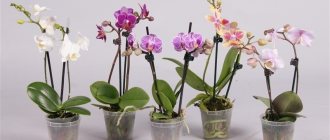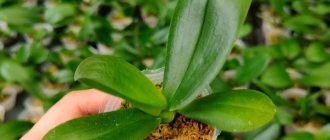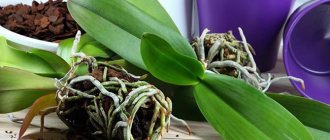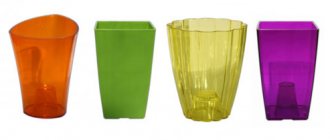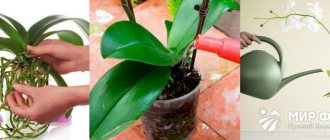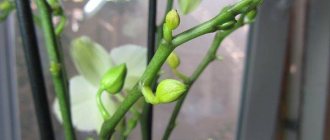You've probably noticed more than once that orchids are sold in transparent containers through which the roots are visible. Considering the epiphytic nature of these plants, this type of container is the most suitable for them. At the same time, there are many other flowerpots on store shelves labeled “for orchids.” These include heavy ceramic pots, colorful plastic containers, and even glass containers. What to choose for a spectacular beauty, and which flowerpot will suit her best?
Is it possible to plant a plant in a translucent container, is it necessary?
Orchid is a type of epiphyte. Epiphytes under natural conditions do not live in the ground, but cling to some plant and send their roots into its bark.
Almost the entire root system of epiphytes is located in open space. Such conditions cannot be provided to plants in apartments with central heating, a lot of equipment and household appliances. The roots dry out and die. The only way out is to place the plant in a pot that will provide an isolated space for the root system.
Many sources claim that the best option when choosing a pot for replanting is a transparent container . But is it necessary to plant an orchid in a transparent pot or not? Experienced flower growers claim that the owner of the orchid needs it more than the orchid itself, and that it is not at all necessary to purchase transparent containers for the capricious beauty.
Compact and fast propagation of succulents
Succulents are quite beautiful, unusual and unpretentious plants. They can be placed in almost any room and under any environmental conditions. At the same time, there are many different types of these amazing plants, for every taste. To quickly and effectively propagate them, you can use a simple life hack with a plastic bottle. To begin, take a small plastic bottle and use scissors to make small round holes in it.
You can insert succulent leaves or cuttings into these holes to allow them to take root. They will receive the necessary moisture from water, a small amount of which needs to be poured into the bottom of the bottle, about two fingers deep. The lid must be closed. New plants will appear throughout the month.
Advantages and disadvantages
A container made of transparent material has a number of advantages:
What the transparent walls of the pot are really useful for is to monitor the condition of the orchid's roots and substrate. This allows you to regulate plant watering, timely detect diseases of the root system or identify pests.- Plastic is a substance that has no pores, so the roots of the orchid will not be able to “grow” to the walls.
- The plastic maintains the optimal temperature necessary for the root system of the flower, that is, it prevents overheating and hypothermia.
- Such pots are better than others at maintaining the required level of humidity.
- If you have difficulty separating the soil from the roots when replanting, you can cut such a pot with ordinary office scissors.
- Doesn't break when dropped.
- This type of container is a budget option.
There are also certain disadvantages:
- Lovers of everything environmentally friendly will actively oppose the use of plastic - a synthetic substance that has a negative effect on the human body and the state of the environment.
- The material from which transparent containers are made is quite light: there will always be a risk that the plants planted in them will turn over.
- In such a situation, the lack of hygroscopicity in the substance can play a bad joke: the orchid will easily fall out along with the substrate.
- Plastic pots are airtight.
- Plastic may react unpredictably to any fertilizers added to the substrate;
- The design is not aesthetically attractive enough.
The first three disadvantages are easy to eliminate: it is enough to “weight” the pot with a layer of drainage (expanded clay, pumice can be used), and to ensure access of air flow to the roots and outflow of water from the substrate, you need to make holes in the bottom and walls of the vessel (a hot nail or spoke).
What types are there?
All pots can be divided into different types according to design features and type of base. They all have their advantages and disadvantages. Main types of orchid pots:
Glass
An orchid is most often given as a gift in a glass flask or vase. The Vanda variety is often sold in this form. Flowers are transplanted into glass pots in order to grow them in a closed system. It is better not to leave them on a cold windowsill, as the roots may freeze.
Plastic
Plastic pots are considered the best option. The roots do not stick to this material, and if necessary, additional holes can be made. It is easy to maintain the correct humidity level in plastic containers. Among the minuses, only one can be highlighted - not a particularly attractive appearance.
Double pots
The design of the container has the possibility of automatic watering. These pots consist of two separate containers. The inner one has many drainage holes. It also has small legs, which creates a gap in which water accumulates.
Crown
The design includes a pallet and a base in the form of rods. Thanks to this, air constantly flows to the roots. But such a pot is not suitable for growing orchids in low humidity conditions. In this case, you will have to water the plant very often.
The best choice is a crown or a regular plastic pot. This does not mean that other types cannot be used. However, the normal development of orchids in other types of pots will be more difficult to ensure.
Effect on various plant species
Before planting a flower in a transparent pot, you need to take into account the specific requirements for the growing conditions of various types of this plant. The root system of Phalaenopsis and Oncidium is involved in the process of photosynthesis, for which light is simply necessary. It is advisable to grow these types of orchids in containers that transmit light.
For the Vanda orchid with its growing characteristics, a glass container is suitable , which will provide light transmission and will be convenient for constantly moving this flower for the purpose of watering and drying the roots. But for the capricious Cattleya and other hybrid orchids with pseudobulbs, glazed ceramics are recommended, as are all terrestrial species (Venus’s slipper).
Advantages and disadvantages of transparent containers
What are the advantages of using a transparent flowerpot, and why should it be preferred to planting it in a regular pot that does not allow light to pass through?
- The roots of the flower gain access to sunlight. This is important for orchids, whose root system is involved in the process of photosynthesis.
For reference! The process of photosynthesis is the production of organic nutrients by a plant from carbon dioxide and water with the help of sunlight and chlorophyll. The described process involves the roots of orchids, which contain chlorophyll.
- Inspect the condition of the root shoots immediately in the pot, without the need to remove the plant from the pot. This allows you not to disturb the flower unnecessarily and inspect it at any time, not excluding the flowering period.
- Regulating watering - whether the orchid needs moisture or not is determined by the condition of the soil inside the pot.
- There is a higher chance of recognizing a disease or the presence of pests in time.
Illumination of root shoots is the main advantage of transparent containers. But illiterate care turns it into a minus. Preservation of excessive humidity inside the pot and lack of air permeability to the orchid roots when exposed to light are the causes of algae formation. Flowers grown in glass containers are especially susceptible to this problem.
Note! When choosing a plastic pot, you should consider its weight. An excessively light vessel does not prevent the flower from turning over.
When you can't do without a transparent pot
Although keeping an orchid in a transparent container makes it easier to care for the plant, gardeners prefer opaque flowerpots with more interesting shapes and colors. Some types of orchids fully develop without access to light to the root system, while for others the lack of light is detrimental. In conditions where the roots do not have access to light, the following varieties do not survive:
- Campylocentrum
- Hyloschista
- Microcoelia
- Polariza
These flowers belong to leafless epiphytes. Their roots contain chlorophyll, which allows them to carry out the process of photosynthesis. The lack of foliage and growing in an opaque pot deprives such a plant of the ability to accumulate energy and develop.
For reference! Epiphytes are a group of plants that attach themselves to trees by their roots. At the same time, they independently obtain nutrients without parasitizing the host.
From the definition of epiphytes it follows that orchids belonging to this species do not need a pot. What are they used for? In room conditions it is difficult to maintain the required humidity; without a container closed on the side, the soil dries out faster.
Replacing the usual plastic containers is using blocks . They are used for growing epiphytic orchids in greenhouses, arboretums, and florariums.
For reference! Natural materials are used as a block - pieces of tree bark, driftwood, pieces of coconut shell. The orchid is attached to them using fishing line or wire.
Flowers there are cultivated on a block, without substrate. These conditions are close to the natural habitat of orchid epiphytes - the humidity in special rooms is constantly at a high level - from 90%.
An intermediate variety of orchids is Phalaenopsis. It is recommended to keep the species in a transparent container, since its roots also have chlorophyll and are capable of producing nutrients from light energy. The flower will not die in an opaque pot, since its leaves will continue the process of photosynthesis. To avoid root rotting and disease, it is better not to neglect the advice on growing Phalaenopsis in a container that allows light to pass through. Lighting the roots helps the flower receive more valuable nutrients, so it increases green mass and forms new shoots.
choose a transparent pot in the following situations:
- There is no experience in keeping orchids. This type of flowers is unique in its care - they need rare and less abundant watering, maintaining high air humidity compared to most house plants. In this case, the plant may look healthy in appearance, have green leaves, succulent roots on the surface, and bloom. However, inside the soil its roots may begin to rot. Then the sooner the grower notices the problem, the higher the chance of curing the plant. Therefore, you need to constantly monitor the condition of the orchid’s root system.
- The orchid was recently purchased. In this case, the buyer, as a rule, does not know about the condition of the substrate or its composition. Therefore, it can be difficult to adjust the watering regime - a dense substrate with a fine fraction in an opaque pot dries out on top, but remains moist longer at the roots.
Advice! When planting an orchid in an opaque container, you should use a substrate with large particles - 1-1.5 cm in diameter. The pot must be equipped with holes to allow excess moisture to drain. If all conditions are met, the likelihood of root rot is reduced.
Only in one case is it necessary to use a transparent container - when the flower is cultivated at home and the roots extract nutrients using light.
Is the opaque option acceptable or not?
If we talk about environmental friendliness, then pots made from natural materials (clay, ceramics) are preferable. But the best option for novice florists is a plastic transparent container , since light transmission allows you to visually observe the condition of the roots and substrate.
An experienced florist, who has studied all the features of each variety of orchids and knows all their “habits,” does not need visualization. He can pay attention to ceramic and clay opaque vessels.
Transparent pot
There are known cases when it is recommended to plant an orchid in a transparent vessel. However, which one should you prefer – plastic or glass? Below is a comparison between plastic and glass.
Material
The most affordable and widely available option is plastic containers. There are several features that make plastic the most suitable material for growing orchids. Compared to glass, plastic has the following advantages:
- Filtration holes are a must for keeping orchids. Aerating the roots will help prevent them from rotting even with poor care. At the same time, plastic allows you to add new holes if the need arises - orchids need additional filtration from the sides. This procedure cannot be carried out as easily with glass.
Advice! To make a drainage hole in a plastic container, you should use an awl or nail, heat the selected tool and make a hole in the intended location. Another way is to drill holes using a self-tapping screw.
Plastic flowerpots can be equipped with legs - about 5 cm high. This improvement makes the vessels even more convenient. Excess water flows out of them freely, and air freely penetrates inside from below.
- Durability, resistance to damage. Unlike glass, plastic is not as susceptible to falls; if it hits a surface, it can crack, but with much less probability than glass.
- Removing an overgrown plant without damaging the root system. If the roots of the flower penetrate into the drainage holes and prevent removal from the plastic container, it can always be cut with scissors. If a similar situation occurs in a glass vessel, it is difficult not to damage the plant.
- Heat retention. This ability of the material makes it impossible for the plant to overcool. This quality is manifested when growing flowers in rooms where frequent and sudden temperature changes can be noticed.
- The plasticity of the material allows manufacturers to create plastic containers of various sizes and shapes. The selection of glass flowerpots is more limited.
- Low price. The cost of a plastic pot varies depending on its size and appearance. The price for a plastic pot starts from 20 rubles and above, for glass pots – from 60 rubles. But their size is different - the glass container is smaller.
It is clear from the list that using plastic flowerpots is more practical. Only in conditions of sharp temperature fluctuations and in the absence of sufficient aeration in the pot is it recommended to use plastic. In other cases, the choice of a plastic or glass container for growing orchids depends on the preferences of the grower himself.
Color
Along with transparent, colorless flowerpots, there are also translucent ones. They can be colorless or painted in various pastel colors. Are they suitable as a container for growing an orchid whose roots need sunlight?
Such flowerpots are used to keep orchids. Light shading of the root system will be useful if the orchid is located in a place where bright sunlight penetrates. This will protect the plant from getting burned.
You should not choose overly shaded pots; they do not allow you to fully observe the condition of the roots.
Size
The size of a transparent or translucent container for growing an orchid is no different from one that does not transmit light. The pot must meet the following parameters:
- It reaches the same height as the diameter of its neck.
- The root system is freely located inside - but the pot is not much larger than it.
- The best option is when the roots are located at a distance of about 3-4 cm from the walls of the vessel.
The container is selected individually, and its size depends on the development of the root system of the orchid plant.
What will unstained containers help you find out?
The transparent material from which the container is made allows you to monitor the development of the root system, the condition of the substrate, and the outflow of moisture. So the color of an orchid’s roots is one of the main indicators of its condition and health . The plant does not need watering when its roots are deep green. If they gradually become silvery-greenish, then the flower is “thirsty.”
If the roots acquire a yellow, brown, or black color, it is time to sound the alarm; this is a clear signal of rotting of the root system or its fragments. In addition, transparency allows you to see how saturated the substrate is with water and when to water the plants next time.
If you really like a glass vessel in a store, then it can be used as a decorative flowerpot, but you need to remember: the distance between the walls of the pot and the flowerpot should be at least 1 - 2 cm .
Pots made from plastic bottles
In debates about which pots are best for orchids, they often use the possibility of installing automatic watering, remembering that an orchid flower in a pot requires a certain soil and air humidity.
To make your own pot with automatic watering, you can use two plastic bottles with a volume of two and one liter. The pot itself and the automatic watering system will be made from them. This is done as follows:
- To make a container for watering, a two-liter bottle is cut to a height of twenty centimeters from the bottom and its lower part is used;
- Eight cuts are made at the top, four centimeters deep, to form stands for the pot;
- The resulting segments are bent inward after one;
- To fill the container with water, the neck is cut off from the remaining upper part of the bottle;
- A hole is marked in the lower part of the manufactured drinker so that a spout can be attached;
- The neck is attached to the cut hole using thermal glue;
Read also: Which greens are more profitable to grow hydroponically
As you can see, pots for orchids at home can be very different, both in material, size and shape, and even in function.
Although an orchid in a pot is considered a rather capricious plant when grown indoors, the correct choice of pot for planting and proper care of the orchid in a pot at home will avoid many problems in its further maintenance. Therefore, you should decide in which pots to grow orchids in advance, before you purchase the plant.
Effect on the flower
Most experts believe that the material from which the container is made has absolutely no effect on the condition of the plant. Neither plastic nor glass can harm your favorite flower; only improper care can cause harm.
Translucent glassware
As mentioned above, a transparent pot is very beneficial for beginner gardeners . They, seeing the condition of the orchid roots, can have an adequate effect on the plant, which, of course, has a positive effect on the flower.
What are the dangers of using a regular flower container?
Despite many positive indicators, an opaque pot does not make it possible to notice problems with the roots if they arise, determine whether watering is needed, or identify the presence of pests. Such a grower must have well-developed intuition and rich experience in order to determine possible deviations in its development by the appearance of the orchid. Otherwise, the condition of the plant may deteriorate, even to the point of its death.
Aloe (Aloe) and Kalanchoe (Kalanchoe)
Despite the differences in appearance, these plants are united by the fact that they are succulents and have medicinal properties. For many years, they were grown on windowsills to be used for inflammatory processes, to treat purulent wounds, and diseases of the respiratory system.
They are unpretentious, love sunny places, infrequent watering, loose, not too fertile soil. In winter they prefer to be in a cool but bright room. Propagating aloe and Kalanchoe is also easy - just plant a side shoot of the stem in moist soil.
Abutilon (Indoor maple)
Abutilon blooms from spring to autumn, and as daylight hours shorten, the number of flower stalks decreases and the plant enters a dormant phase. But if you provide additional illumination with fluorescent lamps, provide fertilizing and watering, flowering does not stop. The leaves are similar to maple leaves, hence the second name. Abutilon flowers look like lanterns of different colors.
Step-by-step instructions on how to plant in different containers
From glass
Attention! The best time to replant an orchid is after it blooms. The pot should not be too large or too small; it will be enough if it exceeds the old one in diameter by 1 - 2 cm.
- Prepare the substrate, pot, expanded clay, scissors.
The plant itself should be prepared: remove it from the old pot, place it together with the substrate (if it is stuck to the roots) in warm water. After some time, remove, wash off the remaining soil from the roots and leave to dry.- When the roots of the plant are completely dried and visible, it is necessary, after carefully examining them, to remove all rotten areas with scissors.
- The bottom of the pot should be covered with expanded clay approximately 5 cm so that water can drain, and with a small layer of substrate. Place the plant on the resulting “cushion”, straighten the root system, place too long aerial roots in a pot, and fill all free spaces with substrate. It should be evenly distributed between the roots, periodically lightly squashing it; the growing point of the orchid should not be covered with bark.
- You need to make sure that the plant does not dangle in the new container.
There are certain difficulties when watering orchids planted in a glass pot without drainage holes. The flower should be watered superficially using a watering can or shower. In order to drain excess water, the container is turned over while holding the flower . For this purpose, some gardeners place moss on top of the substrate to avoid losing pieces of bark. In this way, watering is done 2 times less often than usual.
We offer you to watch a visual video of planting an orchid in a glass container:
Plastic
- Prepare everything you need for planting: pot, scissors, drainage, substrate, activated carbon, maybe cinnamon.
- Water the flower in an old pot first.
- Remove the plant from the container. To avoid injury to the roots, the old container can be cut.
- Carefully examine the roots and cut off rotten areas with scissors.
- It is necessary to remove all dry parts from the root collar of the orchid, where the plant comes into contact with the ground.
- Treat cut areas with crushed activated carbon or cinnamon.
- At the bottom of the pot we place drainage, a little bark, and a plant. The root collar should be in the center of the pot, and the roots should be around the walls of the container. When filling the pot with soil, you need to ensure that the pieces of bark evenly fill all the free space between the roots.
Important! The first watering of the orchid after transplantation should be done with boiled water on the fifth day, the second watering should be done after another 2 weeks, and feeding should begin only after a month.
Opaque
Prepare everything necessary for planting, including the plant itself.- Carefully examine the roots of the orchid, trim off any rotten or dried areas with scissors.
- According to experts, pruning areas should be treated with activated carbon or cinnamon.
- Fill the pot with drainage and some substrate, place the plant itself so that its roots are freely located around the walls of the pot. Fill the resulting voids with soil
- Tap the sides of the pot to allow the soil to settle.
Below is a visual video about planting an orchid in an opaque pot:
You can bring the conditions for growing orchids closer to natural ones by planting the plant on a block or using a special breathable container called Corona. And as a substrate, an excellent soil made in Germany, Seramis, is suitable.
Long-term plant nutrition
Before going on vacation, the problem of caring for indoor plants invariably arises. You have to either ask one of your relatives to water them, or put up with the fact that the plants will die. A simple solution will help you avoid all these inconveniences. You need to put all the plants in the house in one place next to each other, and in the center place a large container with water, for example, a bucket or basin. Then you need to prepare pieces of rope, one end of each should be placed in a bucket, and the second should be slightly buried in the soil of the plants.
Thus, indoor flowers will feed themselves as needed. The water will flow along the rope directly into the pot.
Homemade fertilizer
It is not necessary to buy fertilizer for indoor flowers in the store. It is quite possible to do it yourself. To do this, you need to pour a little rice into a container, then fill it with water and stir. The resulting cloudy water should be poured into ice trays and frozen. You can then add one piece of ice to each flower pot to provide additional nutrition to the plants. Rice contains starch, which has a beneficial effect on the growth of indoor flowers.
What can containers for orchids be made of?
In many containers you won’t see a tropical beauty. People plant it in clay, plastic, glass, flowerpots, but how to choose the best option? Let's consider what kind of pot is needed for a phalaenopsis orchid.
Made of plastic
Plastic containers are the least expensive and therefore the most common. They can be easily drilled to make drainage holes, and the flowerpots are easy to use. Plastic is resistant to temperature changes and ultraviolet radiation. If the orchid's roots begin to emerge from the drainage holes, the plastic walls can be easily cut to free the flower for replanting.
The only disadvantage of such a container is its unstable position: due to its low weight, it can tip over from a slight push.
Ceramic
Ceramic containers create a lot of problems when growing orchids in them. The main trouble comes from the porous structure of the material. The roots of the plant get caught on uneven surfaces, grow to the walls of the vessel, and, as a result, it becomes difficult to remove the orchid during transplantation. Wounds on the root system can cause the death of the flower.
Experienced gardeners who have worked with orchids for a long time manage to successfully keep them in such containers, but this requires careful monitoring of the condition of the vine.
Glass flowerpots
Of course, in a glass container the flower looks exquisite; the glass fits perfectly with the beauty of this exotic flower. However, there are also some disadvantages. It is difficult to make drainage holes in glass, which are so important for the successful growth of a flower. This means you will have to take care of a reliable drainage system. In addition, glass collects condensation, increasing humidity, and provokes the growth of green algae on the roots. Another difficulty is choosing the optimal shape and size of the glass container.
Baskets made of branches and twigs
Baskets woven from branches and twigs are attractive for their decorative effect. The tropical beauty looks especially impressive in them. The best pot in this style is usually woven from natural material (bamboo shoots, tree branches). There are baskets made of plastic and metal.
When using such a container, you should check its inner surface. It should be smooth so as not to provoke root growth. The basket itself is filled with soil, having previously covered the holes in its walls with moss so that the soil does not fall out through them.
To prevent rapid evaporation of moisture, a layer of sphagnum is laid on the surface of the soil. Very often, baskets are used as hanging flowerpots. Orchid varieties such as Stanhopea, Corianthes and Dracula are suitable for growing in such containers.
Hanging planter
The use of hanging flowerpots is determined by two reasons:
- highly decorative;
- protection from accidental damage.
In a house where there are children or pets, a hanging structure will protect the orchid from destruction.
Having chosen a pot suitable for the interior, insert a container with an orchid into it so that a finger can easily pass between it and the wall of the pot. Place the structure near an east or west window so that the plant gets enough light.
Transparent containers
Transparent pots, no matter what material they are made of, improve the visual perception of the flower. Professionals consider them a classic complement to the ethereal beauty of orchids.
In addition to its visual appeal, light passes through the transparent walls unhindered, which improves photosynthesis of the plant’s root system.
Today, the crown pot, created specifically for all types of orchids, has reached the peak of popularity. Made in the form of a pallet, into the edges of which rods made of glass or plastic are inserted, it transmits light, looks original, is stable, and weighs little.
DIY orchid pot
If you have skillful hands, you can try to make a flowerpot for your beauty yourself. You can use plastic bottles or containers for it. It is easy to make drainage and breathable holes in them. The main thing is that the diameter of the container is selected correctly.
Flowerpots can be woven from wire or flexible branches, or glued together from wooden blocks or slats. Wide scope for imagination opens up when finishing a ready-made pot. Jute rope, pieces of colored glass, children's mosaics and much more can be used as an original decoration for the pot.
Rating of the most unusual and beautiful pots for orchids
| Nomination | place | Name of product | price |
| Rating of the most unusual and beautiful pots for orchids | 1 | 1 700 ₽ | |
| 2 | 300 ₽ | ||
| 3 | 1 850 ₽ | ||
| 4 | 3 790 ₽ | ||
| 5 | 240 ₽ | ||
| 6 | 98 ₽ |
Lechuza DELTA All-in-One Set with automatic watering
Rating: 4.9
The leader in the rating was a pot that is optimal for people facing the problem of watering their plants in a timely manner. The product is sold as a set with drainage soil and looks like two containers inserted into one another. The interior has retractable handles and special slots in the bottom. There is a float with a scale, thanks to which you can understand whether to add water or not.
This is the best option for growing orchids. Judging by the reviews, the plant blooms constantly in such a pot. Price – 1700 rubles.
- modern design solution;
- different shapes and sizes;
- ease of operation;
- makes it easier to care for your orchid;
- high quality.
No.
“Crown”, for orchids with tray
Rating: 4.8
Next in the ranking is the budget version of the original design. The pot is a brightly colored needle-shaped basket made of high-quality plastic. The through design provides an optimal microclimate for photosynthesis and oxygenation, ideal conditions for comfortable watering of the orchid.
When water enters the pan, the substrate is slowly saturated with moisture; after drying, the procedure is repeated. The cute design will help decorate your home greenhouse. Judging by the reviews, with this product the orchid comes to life again, the leaves become dark green, and healthy roots appear. Price – 327 rubles.
- unhindered access to light and oxygen;
- pleasant appearance;
- choice of size and color;
- affordable price.
No.
Log & Squirrel with water level indicator
Rating: 4.7
The next line is occupied by a self-watering pot, which will keep the plants alive, even if the owner goes on vacation. It features a double bottom and a unique design. A cute squirrel is built into the outer container, warning you about the need to water the flower. The figurine protrudes if there is a lot of liquid in the pot, and gradually lowers as the soil dries.
The product allows the plant to take as much water as it needs. It is made of strong plastic. Buyers choose flowerpots for their original appearance, compactness and usefulness. Price – about 1500 rubles.
- funny look;
- excellent gift option;
- strong plastic;
- allows you to control the water level.
poor root ventilation.
Eva Solo orchid pot
Rating: 4.6
The exquisitely designed Eva Solo pot provides flowers with optimal conditions for development and growth. With it, the orchid will receive liquid in the required amount through a nylon wick located at the base of the container. The model is made of earthenware and is durable.
The pot comes with instructions for growing flowers and properly caring for them. The catalog contains products in black and white colors. The price ranges from 5800 to 6500 rubles.
- stylish design solution;
- optimal hydration;
- strong material;
- durability.
Not everyone can afford it.
Pot for orchid Adele 1l
Rating: 4.5
The next participant in the rating is a plastic pot at an attractive price. It consists of two containers. One of them is transparent, the other is colored. The latter has slots for oxygen supply. There are drainage holes at the bottom. The transparent container acts as a pallet.
Judging by the reviews, the air circulation in the pot is rather weak. Buyers correct this defect by drilling additional holes. Price – 105-120 rubles.
- reasonable price;
- air holes in the inner container;
- original form;
- interesting design.
insufficient ventilation.
Alternative “Temptation”, for orchids, 1.5 l
Rating: 4.4
The rating ends with one of the most inexpensive orchid pots. It comes in purple color and is made of lightweight plastic. The plant pot is easy to care for and does not create a load on the table or shelf. It is enough to rinse it with water to clear it of soil.
The pot does not scratch the surface and retains moisture for a long time. The walls of the product are decorated with a convex ornament in the form of flowers. The price varies from 95 to 146 rubles. The assortment includes green models.
Protection from caterpillars and other pests
Caterpillars and other pests of green plants can not only spoil the appearance of plants, but also completely destroy them. To avoid this, you can use a creative method of protection: take an ordinary stationery pencil, a sharpener and sharpen it directly onto the top layer of soil. The shavings must be evenly distributed over the entire surface of the earth. Cedar wood, which is often used to make pencils, repels pests.
Features of planting orchids
In nature, an orchid is an epiphytic plant. This means that it does not grow in the ground, but on other plants, namely trees. Therefore, this flower can be planted on a block or in a special soil (substrate). You should choose a planting method based on recommendations for a particular plant type.
Landing on a block
If you want the flower to grow in conditions as similar as possible to those in which it grows in nature, then you should pay attention to planting on a block. A block is a piece of bark that is exactly the size of the plant’s rhizome. While it is still small, you can use polystyrene foam instead of bark
While it is still small, you can use polystyrene foam instead of bark
A block is a piece of bark that is exactly the size of the plant’s rhizome. While it is still small, you can use foam instead of bark.
There are two ways to grow this whimsical epiphyte on a block:
- with substrate;
- without substrate.
Growing without a substrate involves growing an orchid suspended on a wire or fishing line. In this case, the block can be easily replaced with any other bark, driftwood, as well as rhizomes of fern plants.
A type of wood that is not rotten is ideal. For example, a mangrove tree. It can be found in pet stores, as well as in the aquarium accessories departments of markets.
This method of planting will give you the opportunity to water the epiphyte less often, because the moisture will not disappear so slowly, remaining in the substrate.
Sphagnum moss, which grows in swamps, is ideal as a substrate. You can also mix this moss with cuckoo flax, which is common in our area. You can sprinkle ordinary orchid soil into the synthetic mesh.
Some types of orchids need to be grown this way only.
One of the disadvantages is that the root ball will dry out very quickly: in the summer in just a few hours. Therefore, planting on a block is more suitable for growing orchids in greenhouses.
Add to cart
A basket is the best option for those who would like to recreate the natural conditions for a plant, but are not ready to plant it on a block. Baskets come in a variety of materials, such as bamboo and wood, steel, plastic, and metal mesh.
Baskets made of wood and bamboo look original, but wood has a significant drawback: the roots grow strongly to it, so there is a high risk of injury during replanting. Bamboo is a better option in this regard.
You can make your own baskets from wood or bamboo. To do this, just lay out slats or pieces of bamboo, make a hole in them and stretch fishing line or wire, and then hang a homemade basket.
Metal mesh and plastic baskets are considered less decorative, but more practical.
Choose a planting method using recommendations for a particular species.
DIY pot or flowerpot for orchids
A self-made container for growing Phalaenopsis is comparable in its functional characteristics to the store-bought version. You can make such a vessel taking into account the requirements of a particular Orchidaceae species. A handmade pot or flowerpot for orchids can be used as interior decoration, decorating it to your own taste.
The easiest way to make a vessel for phalaenopsis is from a plastic bottle. Since it will be double, you will need two empty bottles with a capacity of 1 and 2 liters. They will become blanks for making a container with automatic watering.
Manufacturing procedure:
- From a bottle with a capacity of 2 liters, cut off the lower half at a distance of 20 cm from the bottom.
- Cut the rest of the part in 8 places to a depth of 4 cm to create container racks.
- The resulting pieces are folded in a checkerboard pattern on the inside.
- To fill the liquid, cut a neck from the remaining top.
- A slot is marked at the bottom of the resulting watering can to secure the spout.
- The neck is placed in it and secured with hot glue.
- The remaining 1 liter bottle is cut off at a height of 15 cm.
- The top is bent to the outside by 1 cm. The stands of the first container are inserted under it to hold the pot.
- Make 10 holes in the bottom of the smaller pot and thread pieces of thick cord through them, reaching to the bottom of the drinker. Along them, the liquid will rise to the roots of the epiphyte.
- Soil is poured into a smaller pot and Phalaenopsis is planted.
- Water is poured into the drinking bowl and a vessel with a flower is placed on it.
- If necessary, liquid is poured through the spout.
What else does a florist need to know?
When replanting orchid babies, beginners often wonder what containers to use. In this case, small plastic or glass containers, designed for about a year of growth, are suitable. This could be a glass jar or a disposable cup. Less often, children are raised in greenhouses or mini-greenhouses.
Recently, pots with additional options have become popular - automatic watering, adjustable phytolighting. Such functions are convenient if the florist often goes on business trips or is away from the apartment for a long time. Some people make self-watering systems themselves, but purchased containers look more aesthetically pleasing and decorative.
Here are some more tips for choosing orchid pots.
- Planting in glass containers requires the gardener to have considerable experience. Overfilling such a container without holes will lead to the formation of algae, mucus on the walls, cause rotting of the roots, and death of the plant.
- When purchasing clay or ceramic containers, you should choose light-colored containers to prevent overheating.
- If you want to plant two or three orchids in one pot, the volume must be selected in accordance with the size of the root systems.
- Before use, it is recommended to heat the ceramic vessel in the oven for disinfection; why soak it in water for half an hour. Soaking in acidified water will help remove salt from the walls.
- To prevent the roots of the flower from growing to wooden surfaces, a mesh container is placed inside the boxes. Baskets made of smooth bamboo do not require such preparation.
- To prevent the substrate from spilling out of the wicker baskets, all cracks are filled with sphagnum moss.
If you choose the right pot and plant the plant, the orchid will quickly take root and will delight you with beautiful flowers for many months. The main thing is to comply with the care conditions, ensuring the required temperature, level of light and humidity of the exotic flower.
Further care for the transplanted flower
No matter how carefully the gardener replants the orchid, the plant will still experience stress from replanting. It needs time to come to its senses (if the orchid had its roots pruned, it will only be able to bloom in a few months).
Important! The orchid is not watered for 3-5 days after transplantation and is kept with minimal lighting. This way the plant tolerates stress better.
They begin to add fertilizing to the water for irrigation no earlier than the first bud appears on the peduncle.
